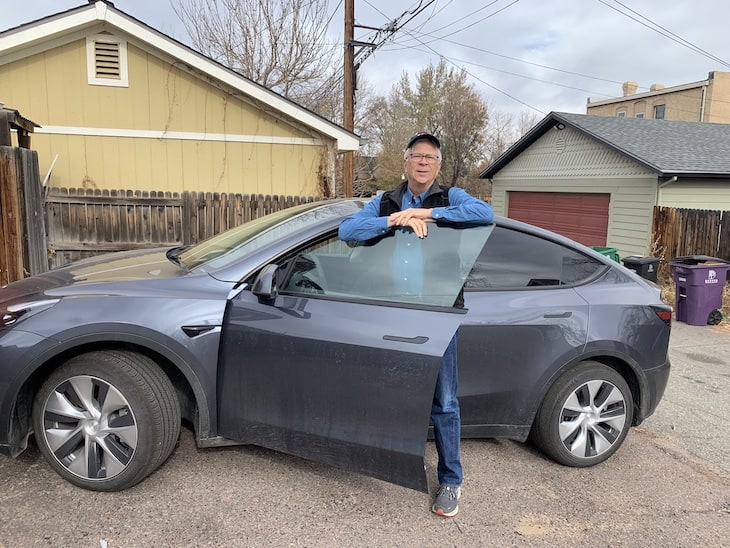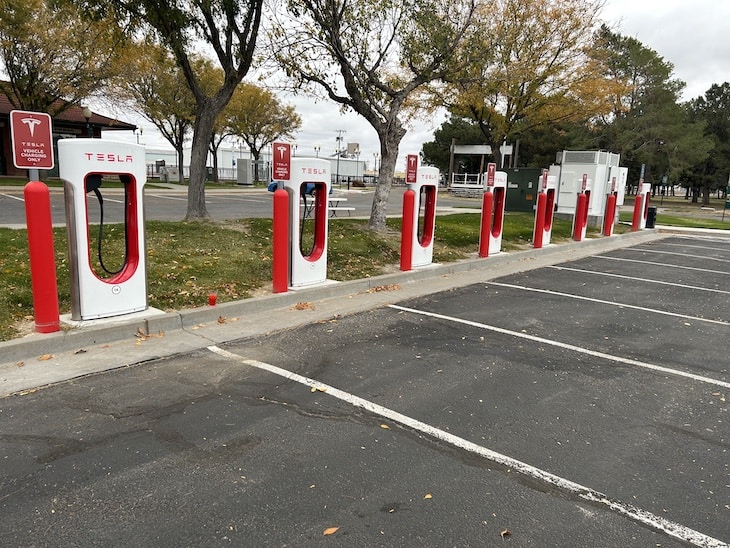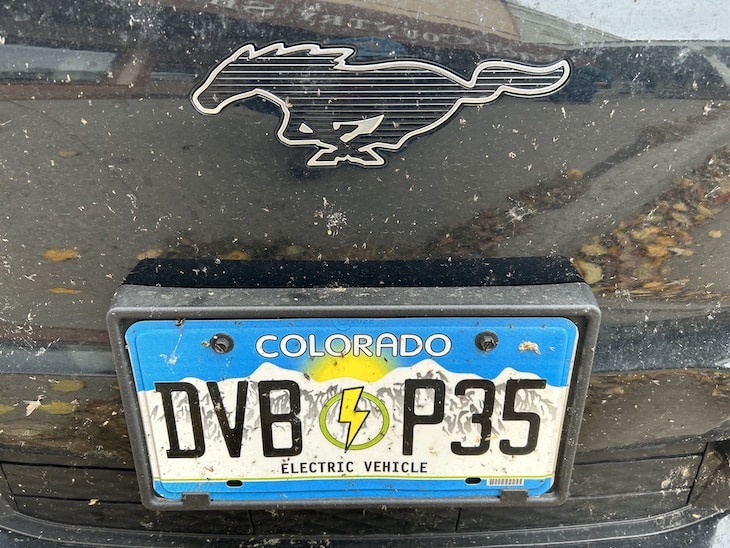EV sales were 17.1 of all new-car sales in thrid quarter. A new tax credit surely explains much. What else is going on?
by Allen Best
Jeff Neuman-Lee, a retired minister who lives in Denver’s Whittier neighborhood, can easily be classified as an early adopter. In 2017, he bought his first electric vehicle, a Leaf. In 2019, when he bought his second EV, a Tesla,, electric vehicles still constituted less than 4% of new-car sales in Colorado.
This year, when he bought another EV, a different model of Tesla, he had more company.
EV sales in the first six months were 13% of total sales in Colorado. In the third quarter sales surged to 17.1%.
“It’s an incredible number,” said Travis Madsen, transportation program manager for the Southwest Energy Efficiency Project, a non-profit advocacy group.
“This also puts Colorado in the top 5 nationally,” Madsen added. “California has been in the 20% range, and it sounds like Colorado is going to hit that mark pretty soon.”
It had better for Colorado to meet the target identified in an EV plan issued in March by the Colorado Energy Office of 25% of all new-car sales by 2025. The plan also calls for 70% of all sales by 2030.
As of mid-November, light-duty EVs constitute 1.27% of all the light-duty vehicles on Colorado’s streets and highways.
In announcing the third-quarter sales, the Polis administration pointed to executive actions, new laws, and tax incentives that together, along with federal incentives, have helped move the market.
“Colorado’s electric vehicle sales are soaring because people know these cars save people money and often have superior performance,” said Polis in a statement.
Denver has the highest number and Pitkin County has the highest per-capita ownership of EVs. Sales notably surged in Weld and Larimer counties.
In this surge, Colorado seems to be bucking a national trend, which has seen a slowdown
A $5,000 tax credit in July
What explains the spike in sales that began this past summer? Part of it, maybe a large part, had to be the new state tax sales credit in Colorado of $5,000 that became effective in July.
“We are starting to see the tax credit result in increased sales,” said Christian Williss, the managing director for transportation fuels and technology with the Colorado Energy Office.
Increased product availability has also helped.
“We are seeing more EVs produced and the kinds that Coloradans like, including crossovers and pickups, we are going to see a lot more interest,” said Williss.
A year ago, it was almost impossible to find an EV on a sales lot in Colorado awaiting purchase. Supply chains created during the covid epidemic were still kinked. Some people continue to wait. One reader of Big Pivots reported only recent possession after ordering in January. But the problems do seem to be diminishing.
Matthew Groves, chief executive of the Colorado Automobile Dealers Association, said he was not entirely surprised by the sales numbers. But he also pointed out that the car sales in Colorado altogether have increased from 194,000 in 2022 to a projected 209,000 in 2023. Unkinked supply chains provide the top reason why.
Also material in the accelerating sales of EVs has been the expansion of public charging stations. Colorado now has 936 public direct-current fast chargers as well as 3,967 level-two chargers, many of them the result of state and federal programs. Still more are coming.
Madsen, who does have an EV, says he gives little thought to charging when driving in the Denver metro area. “I don’t have to think about it very much. If I am on a road trip with my EV, I have to think a little bit, but it’s not hard.”

Jeff Neuman-Lee was an early adopter, buying his first EV in 2020. Now he’s starting to get company in Colorado. Some expect EVs to soon surpass 20% of all sales. T\op photo, Poani’s main street had five EVs on a not-particularly busy Saturday in November.
Sales must accelerate even more to meet the goals set in October by the Colorado Air Pollution Control Commission. That schedule calls for EVs to constitute 41% of all automotive sales by 2027.
“We just made 17%, but we need to better than double that in the next two years if we are going to meet the intermediate goals of that mandate,” said Groves.
The rules adopted by the air quality commissioners require 82% of new vehicles sold in the state to be zero-emissions by 2030.
The rulemaking is grounded in HB19-1261, which set economy-wide decarbonization targets of 50% by 2030 and 90% by 2050. That law gave the Air Quality Control Commission lead authority in implementing rules to get Colorado across those finish lines.
This year, in SB23-016, legislators added new interim goals for decarbonization of the economy: 65% by 2035 and 100% by 2050.
A new modeling study suggests Colorado can hit 98.5% decarbonization of its electricity by 2040 without new technological breakthroughs or without breaking the bank. Very likely, Colorado legislators in 2024 will be asked to approve a law making that mandatory.
One major disagreement in Colorado’s recent rulemaking was whether Colorado should go the same route as California, as conservation groups advocated. California will ban any new internal-combustion vehicles by 2035 — but with one notable exception. It allows 20% of the sales to be plug-in hybrids.
The reasoning for that exception is that the charging infrastructure isn’t yet complete. explains Jon Klusmire, a California resident (and former Colorado newspaperman and also employee of the Rocky Mountain Institute),
“Environmental groups opposed the plug-in hybrids because they only get, on average, about 44 miles on the electric charge, then go to gas,” explained Klusmire.
“I think for urban folks, that electric mileage is probably OK. We rural folks need the gas. For example, it’s a four-hour drive (more than 200 miles) for me (in Bishop) to get to an airport (LA, Reno, Vegas), with the Vegas route going through Death Valley. Not risking running out of juice there.”
In Colorado auto dealers also contend that the benefits of hybrids need to be recognized in this calculation as we try to decarbonize electricity. Hybrids represent a step toward full electrification that can make some buyers more comfortable, Groves said.

Pitkin County has 8 to 10 EVs in its 120-vehicle fleet, including these two cars added this year at the Aspen-Pitkin County Airport. The county plans to double the number of EVs during the next year. Photo/Pitkin County
Pitkin County is part of this year’s surge in EVs. It has had EVs since 2015, but the county government now has 8 or 10 among its fleet of 120, reports Matt Bergstresser, the county’s fleet manager. During the next year the county plans to double its number of light-duty EVs.
“We are looking at Chevy Blazers, Bolts and Equinoxes, some of the models that are a little more cost-effective,” he said. Partly driving the choice of Chevrolet, he said, is a relationship with the company’s support division.
As it turns over its fleet during the next decade, Pitkin County intends to continue adding EVs. It will also start investing in other equipment, such as heavy-equipment loaders at the Aspen-Pitkin County Airport, as they become available.
So far, the costs of EVs remain pricey. But the counter to that short-term cost is lesser maintenance costs. Repairs to EVs are minimal. But until the county gets about 50 or more EVs in its fleet, it will still have to invest in extensive support for maintenance of internal-combustion vehicles.
“We service everything from million-dollar fire trucks to weed-wackers,” says Bergstresser.
Pitkin County has also been investing in charging stations. Construction is underway for two at the Aspen-Pitkin County Airport. “We’re looking 5 to 20 years down the road, so we can really increase the fleet,” Bergstresser said. But that electrical infrastructure for high-speed charging does not come cheap. “It can be a very expensive endeavor.”
Getting charged
Range anxiety has held back some buyers who fear finding themselves some place far from a charging station.
“Getting people to take a test drive or actually owning one is the best remedies for that anxiety,” Groves said.
New technology that will allow Tesla’s widespread charging stations to be used by other vehicles may also lend comfort. But for now, the stories told are somewhat mixed. Those with Teslas are most willing to be free of such anxiety because, well, Tesla early on invested in charging stations in even remote places. A case in point: diminutive Lusk, the only town in Wyoming’s least-populated county.
Neuman-Lee has taken his Teslas on trips to both Chicago and New Orleans without problems in finding places to recharge. Each stop adds 20 minutes for charging, a little longer than refueling for gas. He has come to welcome those longer breaks. “I truly arrive (at destinations) less tired because of having longer breaks,” he said.
His new Tesla has a range of 328 miles, easy enough to get him from Denver to Pagosa Springs. Battery capacity will diminish over time. He expects cold weather to diminish the efficiency by about a third.
His only real complaint is absence of charging at state and national parks.

In southeastern Colorado, downtown Lamar has seven Tesla charging stations and three more charging stations placed there in a program sponsored by the Colorado Energy Office. They seem to get little use. Prowers County, in which Lamar is located, has 17 registered EVs. It is, however, at the intersection of U.S. Highways 50 and 287. Photo/Allen Best
Arvada resident Billie Stanton had an electric car, a Volkswagen ID.4. “It was great around town,” she says.
On the road, she grew disillusioned.
In 2022, as gas prices spiked, she invited friends who travel with her to the Black Hills, the Tetons, Yellowstone, and Glacier. She thought she had done her homework in advance. It wasn’t enough. She learned that driving interstate highway speeds, using the air conditioner, and playing the radio all sapped the battery. Twice she needed AAA to tow her into the nearest charging port.
Too, charging stations that she had believed she would find – well, they were not always operational. Some molasses slow.
She also found safety equipment on that particular model lacking, the deal killer.
“No more EVs for me,” she says. “I wanted to combat climate change, so perhaps my daughter would have a planet to live on for years to come. But I love to travel to the boonies, and those boonies can’t accommodate EVs.”
Newer models have longer range, and for those who stay in Colorado, the charging infrastructure has been rapidly improving. Soon, there will be fast-charging stations from Julesburg to Cortez, Dinosaur to Springfield — in other words, in the four corners of the state.
Following are reasons why sales of EVs will ramp up even more in the next few years:
Multifamily charging
A new state law, HB23-1233,will result in new charging infrastructure becoming part of the norm in parking garages and other parking spaces at multi-family housing projects. The local jurisdictions, when they upgrade their building codes, must require that new wiring be part of any reconstruction or new builds.
Xcel charging stations
Colorado’s largest electrical utility in May submitted its proposal to the Colorado Public Utilities Commission about how it intends to add charging infrastructure for public use. It’s complicated. Madsen, who has studied the plan in depth, says it’s about everything from helping customers navigate decisions about EVs to building out the new wires and transformers and charging stations to make using EVs convenient, particularly in garages, parking lots, and fleet yards.
Many of Colorado’s other electrical providers will follow suit in some form or fashion.
$7,500 off – (for some buyers)
In January, car dealers will be able to offer buyers discounts of $7,500 based on new federal tax credits. The buyer does not need to have that much tax exposure. The dealer can still offer it. The same federal legislation, the Inflation Reduction Act, offers $4,000 on sales by dealers of used EVs.
This is important because it opens the door to buyers who may have little tax exposure of their own, because they have too little income. (Think of those who toil producing e-journals about the energy transition in Colorado).
OK, there’s an asterisk. Actually, a couple of them. The full $7,500 is reserved for vehicles that meet the Inflation Reduction Act’s requirements for assembly in North America. Rules also govern composition of batteries.
Useful in figuring this out is the Edmunds list of EVs and their eligibility. However, it does not include the Xcel Energy EV rebate or the Colorado Vehicle Xchange program.
Also of note as regards this federal tax credit is the income cap: $150,000 for individuals and $300,000 for families. See IRS details.
The law also offers a tax credit for any used EV regardless of where it’s manufactured, but the buyer must earn less than $75,000 ($150,000 for families), and the vehicle has to cost less than $25,000. Details here.
The law does not require dealers to offer the tax credit, however. “I hope they will see the wisdom in doing so, because it will help their sales,” says Madsen.
A $5,000 state tax credit
Colorado also has a tax credit of $5,000 that will continue through 2024 before it steps down. There are no restrictions on this credit, such as where the car was manufactured. This obviously most benefits high-income families or individuals.
Another $2,500 for less-costly cars
Still another tax credit of $2,500 is available for purchases of lower-cost cars, those of $35,000 or less. The intention of this assist delivered by HB 23-1272, said Madsen, is to get a little more financial support for the lower-end of the auto market, where people might need more help.
This tax credit continues through 2028.
More consumer choices
Dozens of new EV models will be introduced by automakers by the end of 2024, reported Consumer Reports in an April article. Toyota alone plans to launch 10 EV models by 2026.
The Washington Post in April noted that prices of EVs had actually been rising because of supply chain conniptions and unexpected demand. Now, they’re coming back down, even as demand continues to rise.
Tesla has controlled roughly half of the U.S. market for EVs. They have started dropping prices while other automakers gear up production. There remains potential for Chinese automakers to offer lower-cost models to the U.S. market the way that Toyota and other Japanese automakers did decades ago.
Why support Big Pivots?
You need and value solid climate change reporting, and also the energy & water transitions in Colorado. Because you know that strong research underlies solid journalism, and research times take.
Plus, you want to help small media, and Big Pivots is a 501(c)3 non-profit.
Big grants would be great, but they’re rare for small media. To survive, Big Pivots needs your support. Think about how big pivots occur. They start at the grassroots. That’s why you should support Big Pivots. Because Big Pivots has influence in Colorado, and Colorado matters in the national conversation.
- Audubon getting into West’s transmission - April 30, 2024
- United Power on cusp of going solo - April 29, 2024
- Can renewables from SE Colorado go east? - April 29, 2024






https://leg.colorado.gov/bills/hb21-1141
Delighted to see this story, Allen. Rep Alex Valdez, Sen Jeff Bridges, and I introduced the bill to establish the EV license plate. Our motivation was to make the public aware of the many EV options that your reporting illustrates. Thank you!
Success, if the consequences were not immediate!